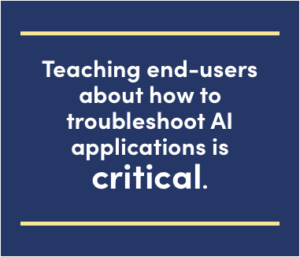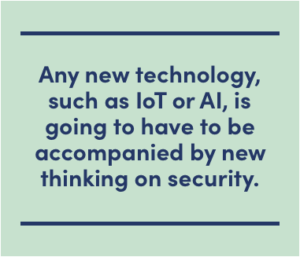We recently talked to Seth Robinson, Senior Director of Technology Analysis at CompTia, about the current state of artificial intelligence in IT, where it’s heading and how IT brands and channel partners can do a better job of marketing AI to IT buyers.
To what extent is AI past being a hype? How many AI applications for SMBs are hitting the market today and how does this compare to recent years?
I think that a lot of people don’t recognize the extent to which artificial intelligence already exists and has existed for quite some time. There are many different kinds of AI, from general artificial intelligence all the way up to “super intelligence.” It’s super intelligence that I think a lot of people are envisioning when they think of AI. So that might be a robot or computer that can think on its own, can make decisions, can observe a wide variety of inputs and process them.

What we have today is much more narrow than that. But it’s still much more powerful than what we had several years ago. Often times, people don’t recognize AI even when they’re interacting with it because it’s baked into a given application. Rather than AI coming out in a discrete product like IBM’s Watson, when a lot of brands talk about AI, they’re talking about it being a part of their products. Microsoft talks about AI being a part of Office 365 or a part of their Skype offering.
So while there might not be a lot of standalone AI applications out there, the number of applications that have some degree of AI capability is growing rapidly.
SMBs are not buying yet, or they are buying in small numbers. Do the big brands now need to urgently jump on the bandwagon or is this just a matter of better educating the market? Or is it both?
Certainly there are things being marketed as pure AI. Cloud brands have platforms and frameworks set up to allow people to insert AI into the applications they’re building. The problem is, SMBs typically don’t do software development in-house. Historically they’ve dealt with packaged software.
This is rapidly changing however. SMBs are increasingly undertaking their own development because they know they need to add customization and automation to their software.
If you are a vendor of a pure AI product that fits into software development, there probably is some basic software development education that needs to happen for SMBs before they can get to the point of using that artificial intelligence in what they’re trying to do.
What needs to be done better about the way that brands promote their AI applications? How should they educate both the channel and end-users about AI benefits?

There is some element of education on what a basic software development process should look like. Software development has changed very dramatically in recent years and so part of a vendor’s job is bringing people up to speed on how things are different now.
For a lot of end-users, AI is a black box that takes some inputs and produces an output. If it’s doing that in an expected way, then it’s producing some kind of benefits in efficiency and productivity. It it’s producing an unexpected result, you have to go back into the training to understand how this thing is making decisions and understand how you can correct for the problem you’re experiencing. So teaching end-users about how to troubleshoot AI applications is critical.
Which business functions will be most impacted by AI applications in the coming years? What’s the best way for brands to explain how these changes will improve business operations?
I think there’s a bit of a shift from describing AI as a standalone benefit and needing to describe them more in service of a larger picture. I think the broader discussion is, if you have AI that is making a process smoother or helping to automate certain functions, that frees up resources and helps the business accomplish more.
For customer service, for instance, you have to describe the basic issues that AI can handle as well as how that frees up the customer service representatives to focus on some of the trickier, more time-intensive problems. That combination will lead to higher customer satisfaction.
But I think you can make the case that AI is going to impact any business unit you can imagine. It’s getting baked into the applications that are already being used, whether it’s Microsoft Office or an ERP system or financial management system.
Which brands are showing us marketing examples to emulate?
Microsoft, IBM, Amazon and Google have all made a point of consistently demonstrating how a new application works. They’re really describing the holistic operation of the application, rather than focusing on the specifics of the AI that underpins it.
In general, I think that’s the right approach. However, if you’re targeting an IT department or an IT solution provider, you’ll probably have to get a little more explicit in order to provide guidance on troubleshooting.
We have talked about what brands need to do, but what about the channel? Does the channel not have an important first line role in advising SMBs about how AI can help accomplish business goals, but also in the ways that workflows need to change when AI is integrated into business processes?
The vendor needs to provide a little more information to the channel partners. And it’s up to the partners to absorb that knowledge and pass that along to the end-users. The partner has a responsibility to describe AI as a layer in a solution stack that’s similar to other layers that an end-user typically doesn’t have to think about.
Ultimately what that end-user needs to know is how that app is working differently and how they can structure their business operations differently without worrying about some of the technical details, particularly if that’s what the channel partner is going to be dealing with.
Let’s bring it close to what your organization does now. What needs to change about the ways that channel IT staff is trained if the channel wants to make maximum use of the opportunities offered by AI?
Training around general software development and overall IT infrastructure is important. Just like most other SMBs, channel firms typically don’t do their own development, so they may not always have a firm grasp on the business goals that software development is meant to address. They’re often focused on the technical details of setting up a network. Regarding the general IT infrastructure, more training is also needed around supporting any software or hardware that is utilizing AI or machine learning, such as CompTIA’s Infrastructure Pathway. Training programs like this can serve as an avenue for building the foundational skills needed.
Do you sense that a lot of businesses may worry about the security implications of AI?

I think a lot of companies are feeling a little skittish about security in general and that moving too fast with technology could put them in trouble. A lot of companies learned that with cloud. They learned that moving applications into the cloud was not the same as moving them into a new server. There was new security needed for cloud migrations.
Any new technology, such as IoT or AI, is going to have to be accompanied by new thinking on security.
Seth Robinson is a senior director of technology analysis at CompTIA, where he analyzes technological trends and publishes reports geared towards both IT professionals and channel partners. The subjects that he tends to focus on include cloud computing, cybersecurity, the Internet of Things, and artificial intelligence.



